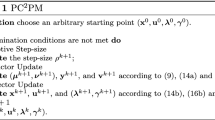Abstract
A distributed approach is described for solving lineality (or linearity) space (LS) problems with large cardinalities and a large number of dimensions. The LS solution has applications in engineering, science, and business, and includes a subset of solutions of the more general extended linear complementarity problem (ELCP). A parallel MATLAB framework is employed and results are computed on an 8-node Rocks based cluster computer using Remote Procedure Calls (RPCs) and the MPICH2 Message Passing Interface (MPI). Results show that both approaches perform comparably when solving distributed LS problems. This indicates that when deciding which parallel approach to use, the implementation details particular to the method are the decisive factors, which in this investigation give MPICH2 MPI the advantage.
Similar content being viewed by others
References
Anitescu M, Potra FA (1996) Formulating dynamic multi-rigid-body contact problems with friction as solvable linear complementarity problems, Reports on Computational Mathematics, No 93, pp 1-7, October 1996
Balsa F, Catthoor F, De Man HJ (1997) Practical solution for counting scalars and dependencies in ATOMIUM-A memory management system for multidimensional signal processing. IEEE Trans Comput Aided Des Integrated Circ Syst 16(2)
Batlle C, Fossas E, Miralles A, Olivar G (2003) The buck converter as a complementarity problem, preliminary report for the fifth framework research project IST-2002-422, Simulation and control of nonsmooth systems, pp 1–4, Technical University of Catalonia, Spain, June 17 2003.
Caire M (2003) Distributed identification of the lineality space of a cone using a heterogeneous network. Master’s Thesis, The University of Texas at El Paso, El Paso, Texas
Choy LY (2002) MATLAB*P 2.0: Interactive supercomputing made practical. Master’s Thesis, Massachusetts Institute of Technology, Cambridge, MA, September
Cottle RW, Pang JS, Stone RE (1992) The Linear Complementarity Problem. Academic Press, San Diego
Davis C (1954) Theory of positive linear independence. Am J Math 76:733–746. doi:10.2307/2372648
De Shutter B, De Moor B (1995) The extended linear complementarity problem. Math Program 71(3):289–325. doi:10.1007/BF01590958
De Shutter B, De Moor B (1995) Minimal realization in the max algebra is and extended linear complementarity problem. Syst Control Lett 25(2):103–111. doi:10.1016/0167-6911(94)00062-Z
De Shutter B, De Moor B (1996) A method to find all solutions of a system of multivariate polynomial equalities and inequalities in the max algebra, discrete event dynamic systems. Theory Appl 6(2):115–138
De Shutter B, De Moor B (1994) Minimal realization in the max algebra, Technical Report 94–29, ESAT-SISTA. KU Leuven, Leuven, Belgium, May 1994
de Berg M, van Kreveld M, Overmars M, Schwarzkopf O (1997) Computational Geometry, p 30. Springer, Berlin
Dula JH, Helgason RV, Venugopal N (1997) An algorithm for finding eth frame of a pointed finite conical hull. Inf J Comput 10(3):323–330
Dula JH, Lopez FJ (2006) Algorithms for the frame of a finitely generated unbounded polyhedron. Inf J Comput 18(1):97–110
Ferris MC, Pang JS (1997) Engineering and economic applications of complementarity problems. Soc Ind Appl Math 39(4):3–19
Francis RL, White JA (1978) Facilities location and layout. In: Moder JJ, Elmaghraby SE (eds) Handbook of operations research: models and applications, vol 2. Van Nostrand Reinhold, New York, pp 229–267
Giang T, Bradshaw G, O’Sullivan C (2003) Complementarity based multiple point collision resolution. In: Fourth Irish workshop on computer graphics, 2003
Gropp W (2008) Tutorial on MPI: the message-passing interface, mathematics and computer science division. http://www-unix.mcs.anl.gov/mpi/tutorial/gropp/node101.html#Node101. Argonne National Laboratory, Argonne, IL, 60439
Gropp W, Lusk E (2001) Installation and user’s guide to MPICH, a portable implementation of MPI, Version 1.2.5, the ch p4 device for workstation networks, mathematics and computer science division. Argonne National Laboratory, Argonne, IL, 60439
Hart GD, Anitescu M (2003) A hard-constraint time-stepping approach for rigid multibody dynamics with joints, contact, and friction. In: Association for Computing Machinery, TAPIA’03, October 15–18 2003, p 34
Koller D, Megiddo N, von Stengel B (1994) Fast algorithms for finding randomized strategies in game trees. In: Proceedings of the 26th annual ACM symposium on theory of computing, 1994, pp 750–759
Lopez FJ (1999) Algorithms to obtain the frame of a finitely generated unbounded polyhedron. Doctoral Dissertation, University of Mississippi, University, MS
Mathworks Inc. (2008) MATLAB Release 14 Online Documentation. http://www.mathworks.com/access/helpdesk/help/toolbox/optim/ug/f3708.html, May 27 2008
Mathworks Inc. (2008) MATLAB Release 14 online documentation. http://www.mathworks.com/access/helpdesk_r13/help/techdoc/MATLAB_external/MATLAB_external.html, May 27 2008
MPICH2 Users Guide (2008) Version 1.0.7, Mathematics and science division. Argonne National Laboratory. Argonne, IL, 60439
Murty KG (2008) Linear complementarity, linear and nonlinear programming, Internet edition, Chapter 1. http://ioe.engin.umich.edu/people/fac/books/murty/linear_complementarity_webbook/, May 27 2008
NPACI (2006) Rocks User’s Guide. http://www.rocksclusters.org/rocks-documentation, UC Regents, 2002. Last Accessed 1 February 2006
Stevens WR (1998) UNIX Network Programming, Networking, Networking API’s: Sockets and XTI, vol 1. Prentice-Hall, Englewood Cliffs
Stevens WR (1998) UNIX Network Programming, Networking, Interprocess Communications, Vol 2, 2nd edn. Prentice-Hall, Englewood Cliffs
Sauer J, Schomer E (1998) Constraint-based a approach to rigid body dynamics for virtual reality applications. In: Proc ACM symposium on virtual reality software and technology, VRST’98, Taipei, Taiwan, November 2–5 1998
Sadahiro T, Yamakita M (2003) Landing control of acrobat robot (SMB) satisfying various constraints. In: Proceedings of the 2003 IEEE international conference on robotics and automation, Taipei, Taiwan, September 14–19 2003
Wallace SW, Wets RJ-B (1992) Preprocessing in stochastic programming: the case of linear programs. ORSA J Comput 4(1):45–59
World Foundry Online Documentation Linear Complementarity Problem (2008) http://tenetti.org/cgi-bin/twiki/view.cgi/WorldFoundry/LinearComplementarityProblem, May 27 2008
Wets RJ, Witzgall C (1967) Algorithms for frames and lineality spaces of cones. J Res Natl Bur Stand, B Math Math Rhys 71B:1–7
Zucker SW (2008) Which computation runs in visual cortical columns? To appear in Problems in Systems Neuroscience. http://www.cs.yale.edu/homes/vision/zucker/papers/Zucker01_columns.ps.gz, May 27 2008. Oxford University Press
Zapata S (2004) Analysis of cluster interconnection network topologies. Master’s Thesis, The University of Texas at El Paso, El Paso, Texas, July
Author information
Authors and Affiliations
Corresponding author
Rights and permissions
About this article
Cite this article
Caire, M.E., Lopez, F.J. & Williams, D.H. Distributed identification of the lineality space of a cone. J Supercomput 48, 163–182 (2009). https://doi.org/10.1007/s11227-008-0222-0
Received:
Accepted:
Published:
Issue Date:
DOI: https://doi.org/10.1007/s11227-008-0222-0




